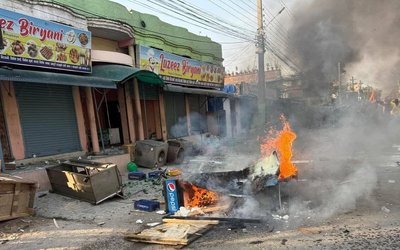
At a time when the time is coming closer to meet the target meet the target of ensuring water and sanitation for all, political leaders most second tire from various parties have expressed their commitment toward the goal.
"Yesterday, WaterAid in Nepal invited political leaders (the really big ones were too busy to come, but they sent their second-tier leaders) at a function at Thapathali's Trade Tower where they made commitments that their parties' election manifesto would give sanitation a high priority as a basic building block of bikas They also made public a simple, Nepali how-to manual on "How to turn your VDC/Municipality into an ODF VDC/Municipality," writes Ashutosh Tiwari country representative of WaterAid Nepal in face book wall.
According to Tiwari, WaterAid Nepal's advocacy strategy is built on two pillars: Continuously engage with national and local government and political bodies to push for policy, practice and mindset change for better and more water and sanitation work, especially on behalf of the voiceless, gather, verify and then distribute relevant information -- in the form of book-lets, data-sheets, fact-sheets, and how-to manuals -- to as many communities as possible all across Nepal so that the local people -- i.e. local politicos, local journalists, local community leaders, etc -- have access to the needed information to make locally appropriate decisions on their water and sanitation needs, aiming to sensitize political parties on water and sanitation issues.
Former MP and leader of Nepali Congress Nabindra Raj Joshi stressed the need to have one voice on ensuring water and sanitation. Joshi called political parties to make it the political agenda in the next CA election as well.
Facilitated by former Environment Minister Ganesh Sah, Kasturi Pradhananga of Sashakti Nepal Party, the party leaders Jitendra Singh of Tarai Madhesh Loktantrik Party and Bishnu Raj Aryal, leader of Nepal Communist Party, Marxist-Leninist was among other to express political commitment. Rajendra Aryal, president of FEDWASUN opened the program.
An information toolkit was also launched during the program that highlights the current status of Open Defecation Free areas in the country, including the future strategy to ensure the water and sanitation to the public. While the government has set 2017 as the deadline for meeting the universal target for access to basic sanitation by all the citizens of Nepal, the present achievement rate has been sluggish.
Nepal government has to declare all 75 districts as ODF in four years. But, only 915 VDCs among the total 3915 have become ODF till now, which is only 24 percent of the total VDCs.
The National Census 2011 showed the dismal picture on sanitation and water. According to census, as many as 82.7 percent total household is under drinking water coverage. However, only 47.78 percent households are receiving safe drinking water supply from tap whereas 35 percent households using water from tube well and hand pumps. The sanitation coverage is still low as only 61 percent households have toilet though the government has to meet 100 percent toilet coverage by 2017.
Organized by WaterAid Nepal, together with Federation of Drinking Water and Sanitation Users Nepal (FEDWASUN), political leaders discussed all the issues intensively.
- NEPAL-THAILAND: Joint Business Council
- Apr 13, 2025
- BIMSTEC SUMMIT: Nepal’s Stand
- Apr 11, 2025
- IME GROUP: Expands Into Paper Industry
- Mar 24, 2025
- CPN UML: Instigated By India
- Mar 23, 2025
- ADB’S CHIEF ECONOMIST: Nepal Reduces Poverty
- Mar 11, 2025















